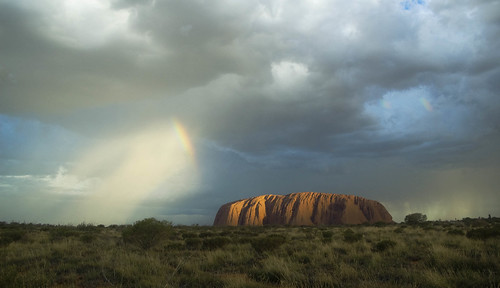
A Rainbow Casting a Magical Light Shines by Uluru ,Electric Storm Clouds Light the Background
 “I know who you are, I’ve seen you outside three times already today. A bit busy earlier eh. And we’re happy to help, no worries, it’s a great idea”, said Jo George of The Rock Tour, as I sat down to talk to him, mouth half open, uncomprehending, but pleased, very pleased in fact.
“I know who you are, I’ve seen you outside three times already today. A bit busy earlier eh. And we’re happy to help, no worries, it’s a great idea”, said Jo George of The Rock Tour, as I sat down to talk to him, mouth half open, uncomprehending, but pleased, very pleased in fact.
A Nearby Storm Changes the Mood of Uluru Bringing Intense Colours
Having just got to Alice we did what we usually do, and got in touch with as many people as we could find, to see what we could arrange to do, to see and to go to. We contacted a host of people – the usual requests for work, the newspapers, radio stations, and tour companies, as it was our intention, while in Alice to see if we could arrange a trip down to Uluru (Ayers Rock), the red centre, and see what millions of people each year go to see. It is as iconic a sight as any in the world, and we realised we would not be able to drive there in the good old van, it being unfeasible to drive the 1000 kilometre round trip, with fuel stations scarce, and so far to travel. So, we emailed the tour companies, and set off to town to follow up.
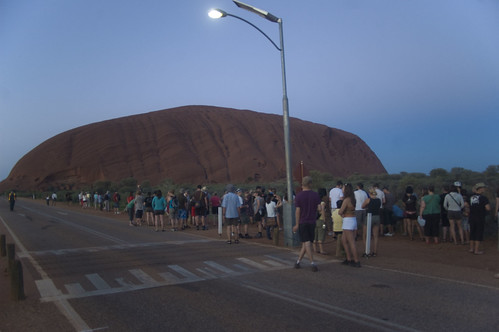
A Picture of Uluru you never see on a Postcard, the Human Traffic at 5am trying to capture that perfect snap
When we arrived in the centre of Alice, Anne and I set off in different directions, branching out from Todd Street, along Gregory Terrace and Parsons Street respectively, with a list of tour companies the ever industrious and type-happy Phil had emailed. Oh how so very far we have come. Phil, whose one email a year used to take him nine months to excruciatingly compose, his index finger raw with effort, his tongue lolling like a dead dog, the concentration lines furrowed and deep. “H……..E…….L…L…..O” used to take him three hours, to compose himself and stop the sweating, and now, stick a keyboard and a monitor in front of him and he practically speed cut-and-pastes emails to people. What did you think? That he touch types? In his wildest dreams.

The first few people were tour agents, and could not help. There were a couple of shops along Todd St, but both The Rock Tour and Emu Tours were pretty busy, so I went off to try again later. Coming back after a fruitless search for more tour companies, I walked past The Rock Tour and they were still busy, so I wavered before deciding to go next door to the other tour company. They could not help either. Leaving the shop, I met up with Anne, who had not had luck either, and now, between us we had one name left on the list, The Rock Tour.

We walked in, they were still busy, so we sat and waited a while on the couch inside. As soon as we went to say hello, he told us he’d seen me walk by, had read the email Phil (oh Phil, what glorious emails he writes) had written, and sure, why not, he’d be happy to help. His name was Jo George, and they could fit us in on Monday, six days hence, for a three day, two night tour down to Uluru, Kings Canyon and Kata Tjuta, was that ok?
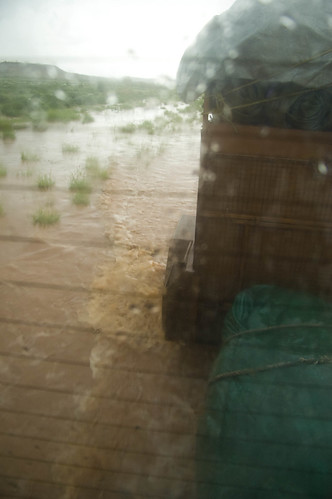
The roads are flooded and our swags get a little wet
We had barely spoken three words. Was it the magic of the email? Was it the magnanimity of Jo, a combination of both, or timing on my behalf, showing a bit of leg, then going, and coming back, that did it? Who knows. What we did know was that in less than a week we would be seeing what we had come here to see.
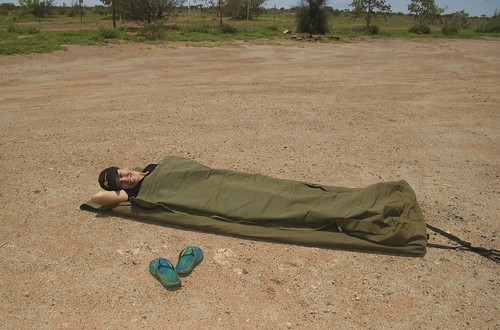
Anne relaxes in her swag
It was a 6am start, there was a busload of people to fetch, and we were there bright and early, bleary eyed but bushy tailed. Craig, our tour guide, was an affable, genial fellow, and we took to him straight away. The bus was a twenty seater, pulling a trailer into which we deposited our bags. After picking the rest up, it was a full house, and we realised that they could probably have filled the three seats we were occupying too, making the act of donating this trip to us all the more generous.
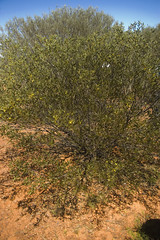
A widgety Bush
It took us the morning to get down to Kings Canyon. The road was flooded in parts, due to the heavy rain fall, and Craig took it easy crossing where it had overflowed, there being the possibility of pot-holes and the always present danger that some of the road had been washed away. Someone asked Craig why they did not build a bridge, or a tunnel or raise the height of the road where it flooded, and he supposed, rightly to my mind, that with thousands of kilometres of road, and floods a few days of the year, it was a mighty undertaking to travel all that way, with all the gear, into the middle of nowhere, to build a bridge, the crossing of which would be pointless if the rain decided to fall somewhere else during next years wet season.
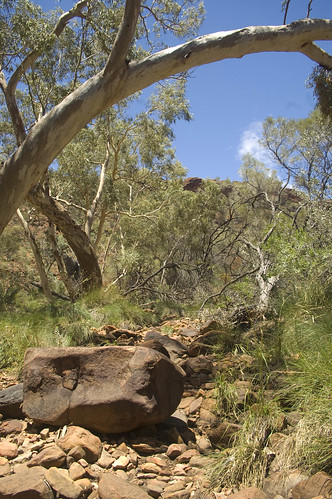
One thing the rain does is make the red centre green. During the Wet it comes alive, all the dormant seeds and patient vegetation race to grow, taking advantage of all the water to spring into life and a growth spurt ensues. Expecting it to be all red earth, scorched and sunburnt, barren and arid, and for miles around there is green grasses, healthy bush vegetation and burgeoning foliage, the greens of which defy description, there being so varied and assorted a hue to all the plant life now loving it and having a great time. But we made it to Kings Canyon without dramas. It certainly was worth the drive. Carved out from millions of years, the Canyon looks the part. We were to go on a walk up and around, to take approximately five hours. It was very hot but the opportunity to really stretch our legs had us all eager to go. Taking plenty of water we started off. Within seconds we were sweating buckets, but the wonderful views took our minds off it.
The horizon stretched far out in front of us, the rich verdant greens and the deep now sodden ochre-red of the earth creating a view that just got better the higher up the canyon track we walked. The view from the Canyon was breathtaking; at least, it took what little breath we had left. Riven and separated through millions of years of erosive forces it is a sprawling testament to the architecture of nature, with sheer drops, and high walls, deep lagoons, and impressive ridges.
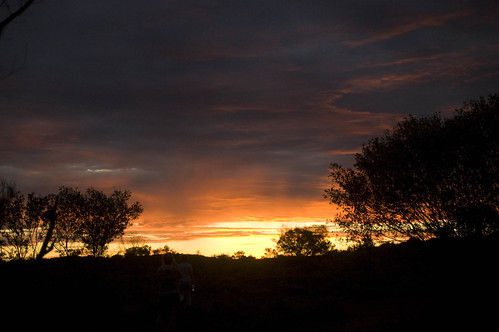
Walking back down with the cathedral-like protuberances walling us in on either side, the breeze coming up against us to cool us down. Back at the bus, Craig had taken it easy, and was having a nap, unsurprisingly deciding not to join us today. With two tours a week, he must see the Canyon plenty of times. We were fed and watered, before heading to Uluru-Kata Tjuta National Park, our next destination. Picking up plenty of fire wood along the way, we were to camp out that night, under the glorious Starlight Hotel, in swags, around a campfire.
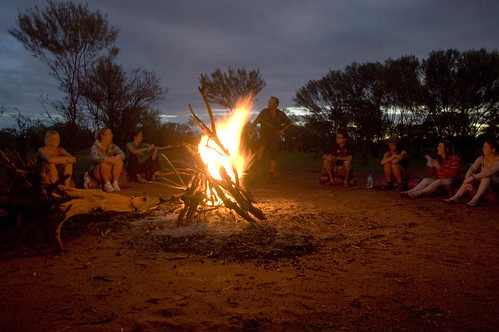
Early the next morning we were to visit Kata Tjuta (or The Olgas as they are also known). We made camp, unloaded the wood, passed it to Craig who got the fire going. We then rolled out the swags, dried them out in front of the fire and helped Craig cook the dinner for us all on big pots placed on some scooped out embers.
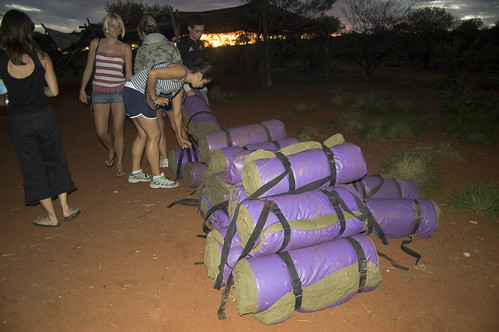
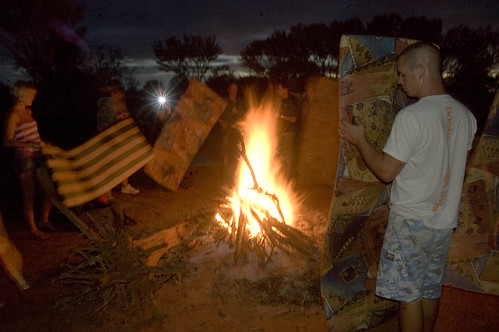
After the rain, each matress inside the swags need to be dryed off at the fire
Our first night under the stars passed quietly, without the threatened rain. We all awoke at some point during the night, perhaps the mossies, maybe a sore shoulder that needed to be rotated, but whatever it was, the sight above us, as we rolled onto our backs, was of an outstanding display of stars, with barely a gap between each one, the night sky crisp and clear, and billions of irradiating lights glimmering in a perspective display.
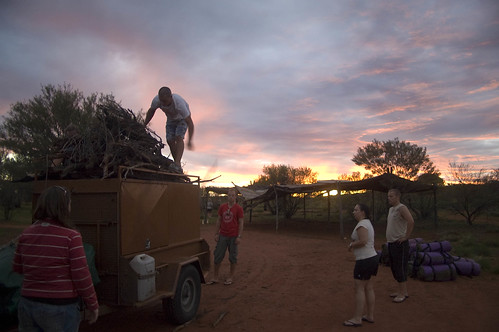
The boys work hard at unloading the trailer
When we woke, Craig already had last night’s fire going again, and coffee on the boil. After breakfast we packed everything away and all piled into the bus again on the way to Kata Tjuta. Uluru-Kata Tjuta National Park is now owned by the traditional occupiers of the land, the Yankunytjatjara and Pitjantjatjara people, who call themselves the Anangu. The title deed to Uluru-Kata Tjuta land trust was handed to the Anangu by the then Governor General of Australia Sir Ninian Stephen in 1985. They in turn leased the land back to the Federal Government for 99 years, working together with the Director of National Parks in managing the land. Listed now as a World Heritage area for both Uluru (Ayers Rock) and Kata Tjuta (The Olgas) it comprises much of cultural importance to the Aboriginal people of the area, as well as being in possession of supreme natural power and beauty. Much is asked by the Anangu of visitors to respect certain aspects of their culture, to not stray from the tracks, or take anything with you, not a stone or blade of grass as souvenirs.

Kata Tjuta (The Olgas)
The area is rich in dreamtime stories, the tales by which the Aboriginal people taught their children about the land, who they were and where they came from. The Tjukuritja were the creation ancestors, who, in their travels, left marks in the land and made the laws by which they live. The dreamtime stories are the inheritance of 40 000 years, they are the conditions for life, and inform, educate and guide also.
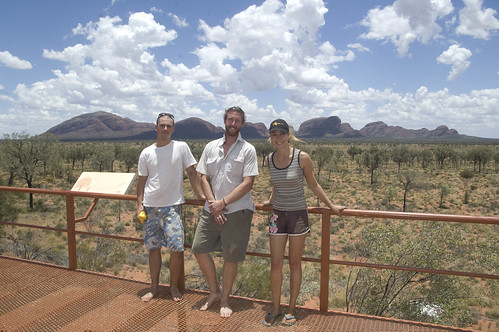
The Obligatory Tourist Picture
Arriving at Kata Tjuta, which is a Pitjantjatjara word meaning ‘many heads’, it was early enough to walk around without losing a pint of sweat a second. The 36 steep-sided domes lie about 36 kilometres west of Uluru and is an important and sacred place under Anangu men’s law. Under this law, details of the dreamtime stories associated with Kata Tjuta cannot be revealed to the uninitiated, and certain areas are off limits too. This gives it all an imposing feeling, and walking around you sense the untold stories in the lines and undulations of the domes, in the shapes of the rocks, and the scars they bear. Scientifically, these features can be put down to erosion, weathering, and time, but to the Anangu, every feature is a story, the lines and scars are the result of some ancestral creature, a creation story would tell how it got there and why. Walking through The Valley of Winds, it was a far more magical feeling to imagine the spirit of the place travelling on the breeze; the connection the Anangu had with it all, and the deep meaning they ascribed to being there.
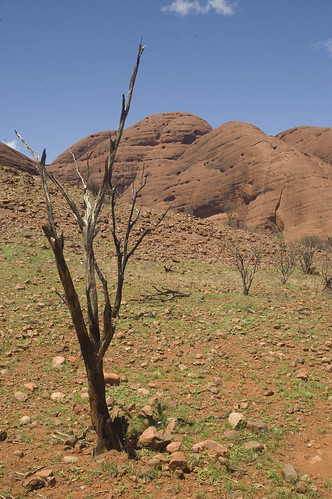
A scientific explanation may factually suffice but a story brings things alive, paints pictures in your mind and makes it all the more real for being infused with that living pulse of energy. The rounded domes were beautiful, natures abhorrence of angles creating the smooth curved shapes. As we walked around, Craig would stop us and explain some of the features to us, and give talks on the Aboriginal culture. It was fascinating to hear about this while being able to imagine the conditions under which they would have lived.
Shortly after this we drove the short distance to Uluru, for the sunset view. Stopping at the Culture Centre first, we had a brief look around, to acquaint ourselves some more with the people who for so long lived here alone. Their culture is story driven, theirs is a culture of stories, orated, remembered, transmitted down generations. They have stories for everything, and everything has a story. Grandmothers and Grandfathers, the elders of the group, pass on these stories, the old teaching the young. Tjukurpa is the foundation of their culture, their traditional law, and the very ground on which they live, and have lived since time immemorial. It is more than the ‘Dreaming’ or ‘Dreamtime’, in the sense that to them it is not an imaginary tale, or fleeting, but real and much more complex. Tjukurpa is their religious heritage, explaining their existence and guiding their lives, the rules of daily life and the solution to quarrels and disputes. It is the law for getting along with each other and for caring for the land. The Tjukurpa tells of the relationships between people, plants, animals and the physical features of the land.
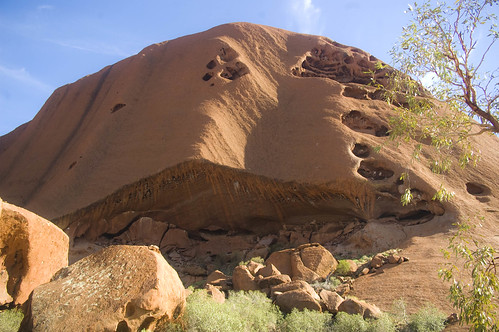
Some Features of Uluru
Everything is timeless. The Tjukurpa refers to the past, the present and the future at the same time. It is taught and memorised, and passed onto the young people, with some areas only passed on to those who have inherited the right to that knowledge, or come of age and earned the right to it. The boys leave to go walkabout and come back sometimes many years later, as men. The women too, have their own rites of initiation. The men cannot know the women’s business and the women cannot know the men’s. The Tjukuritja (Ancestral Beings) are taught to them in stories, special places, songs, dances and ceremonies. According to the Tjukurpa, the land was once a featureless place, until Anangu ancestors, in the form of people, plants and animals, travelled widely across the land, and in the process of living and travelling they formed the world as it is today.
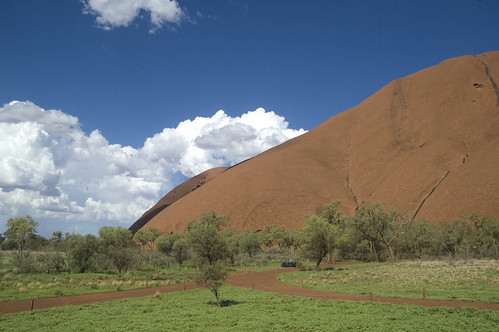
To the Anangu, the land is inhabited by dozens of Tjukuritja, and their journeys and activities are recorded at sites by Iwara (paths or tracks). The Iwara link places that are sometimes many hundreds of kilometres apart. The Tjukuritja effectively mapped the land, and in telling of their events, the Tjukurpa infuses great meaning to the landscape. All across the land they see evidence of the activities of the Tjukuritja and that therefore they still exist. All knowledge of the land and the behaviour and distribution of plants and animals, so important to daily survival, is based on their knowledge of Tjukurpa.

The path to Uluru's summit, which was closed when we arrived due to the heat
We saw an Uluru sunset, watching the rock change from a bright red to a dark red in minutes, before heading back to camp for the sunrise view. After the not so spectacular sunrise, due to the overhead clouds, we were to see it up close, walking around the base. Phil had gone barefoot, to feel the earth under his feet, and we all set off on the seven kilometre pilgrimage.
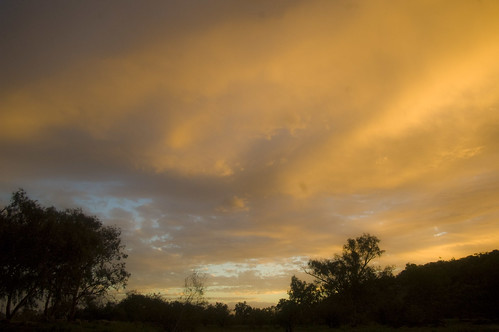
The Anangu ask people not to climb the rock, although there’s nothing stopping those who really want to, of course. It was part of the agreement in handing the title deed over that they would not prevent people walking up Uluru. They relented, of course, but an analogy would be for a bus load of Japanese tourists, say, to visit Westminster Cathedral, and clamour up onto and over it. Uluru is revered rock to the Anangu, with areas only initiated men can visit, and areas only initiated women can go to, with many Tjukuritja stories about the features of the rock and how they occurred.
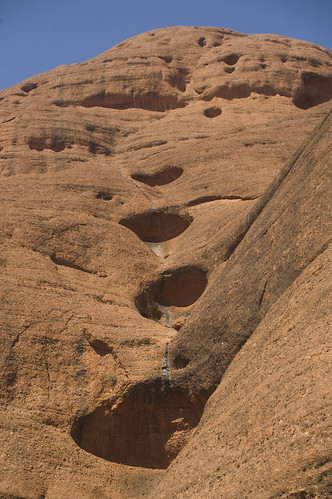 #
#The Pockmarked Ayers Rock Close Up
It is a spectacular rock up close. It rises from the ground, literally, as there is more than 5 miles of it underground, the rock being the tip of a absolutely huge monolith. It is pockmarked and scarred, it undulates and seems to move as you approach, and for the most part completely bare, with very little foliage growing on it.
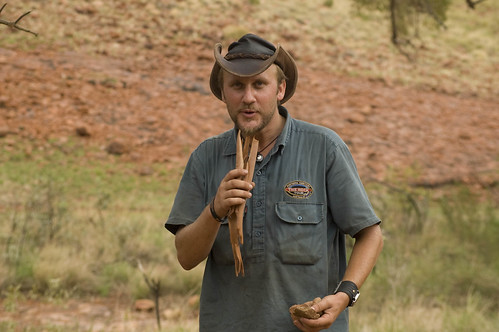
Craig explains that Aboriginals made fire the old fashioned way by rubbing sticks together
Some areas are off limits, considered sacred sites, and therefore inaccessible, with fines for taking pictures of these areas. The walk around the base took a good while, but to see the rock up close, to see this shrine as it was to the Anangu, was awe inspiring. Again, to imagine for a second how this rock was seen and understood by them made it all the more special. The narrow caverns carved out of the rock where they met and talked, where the children played and stayed out of the way when the men were ‘in ceremony’. The areas the men took the boys to get initiated, or where the women took the girls to pass them into the next stage of life, the different facets of the rock, each feature telling a story, tying the rock to the land and the whole to themselves as people and individuals.
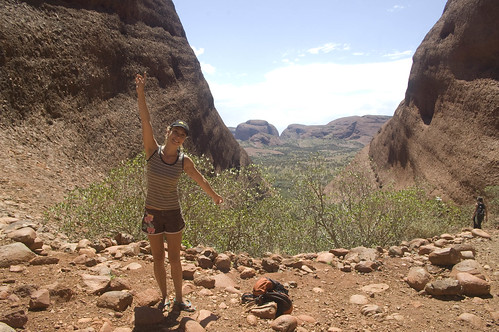
Anne Celebrates her climb without slipping, in her inappropriate hiking flip-flops, the only footwear we have been given
There is a series of boulders where the Woma python laid her eggs; there is a mark left by Liru the venomous snake; Kurpany, the giant dog-like creature left his paw print on the side, when he came to try to kill the Anangu. There are many more stories, and the rock came to life imagining all of them, some of which are unknown by members of the Anangu themselves, there being certain stories only certain people are entitled to hear.
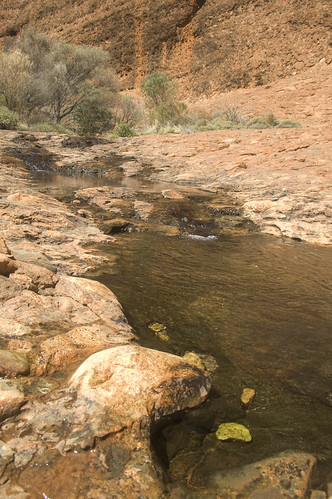
The drive back to Alice Springs was made later that morning. It was an absolute pleasure to have been able to visit the red centre, even if it was green. To Craig and to Jo George at The Rock Tour we owe much. An incredible opportunity to see one of the most remarkable and well-known of Australian sights, and it was one we are deeply grateful for, in more ways than one.

Nice Work Craig, we thoroughly enjoyed your knowledge on this tour!
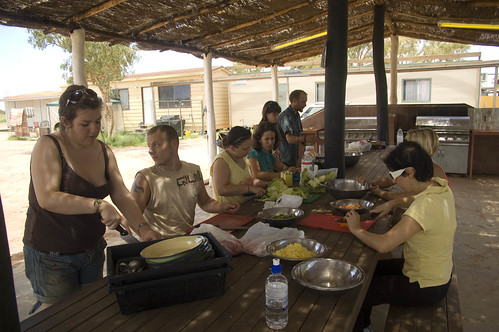
We all help prepare lunch
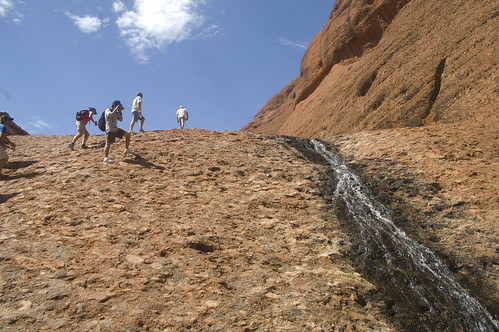
During The Wet there is water around and on some parts of Uluru
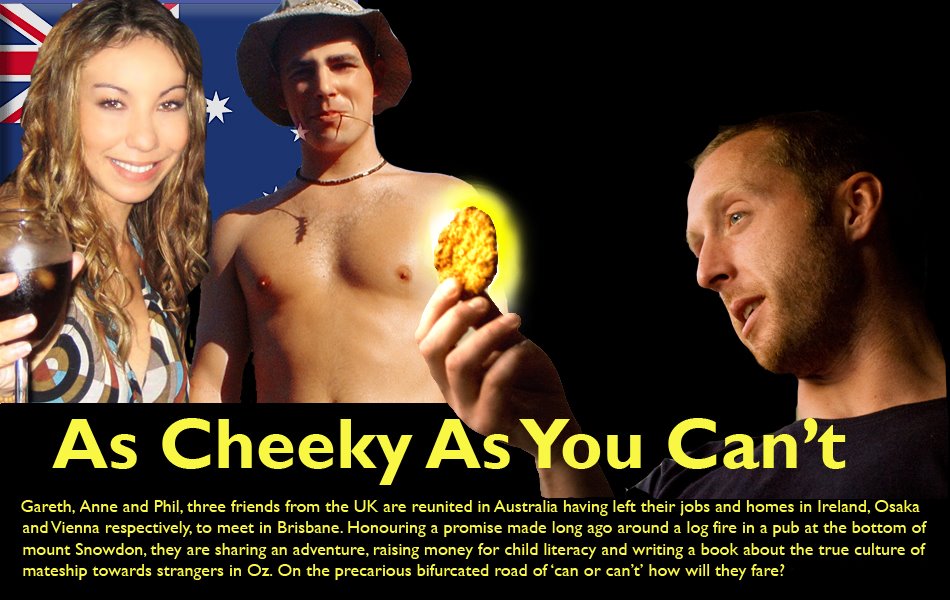




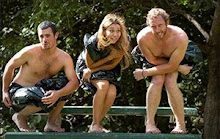
















1 comment:
how cool that you guys got to go on the tour! i always wanted to go to uluru. nice job hiking in flip flops, anne...i remember doing that in the philippines when we were on that little island with the dream lagoon, where that dude almost dropped your camera in the water. anyway, i also like how you changed the layout so that the latest post is the first thing on the page. nice work dudes!!!
Post a Comment